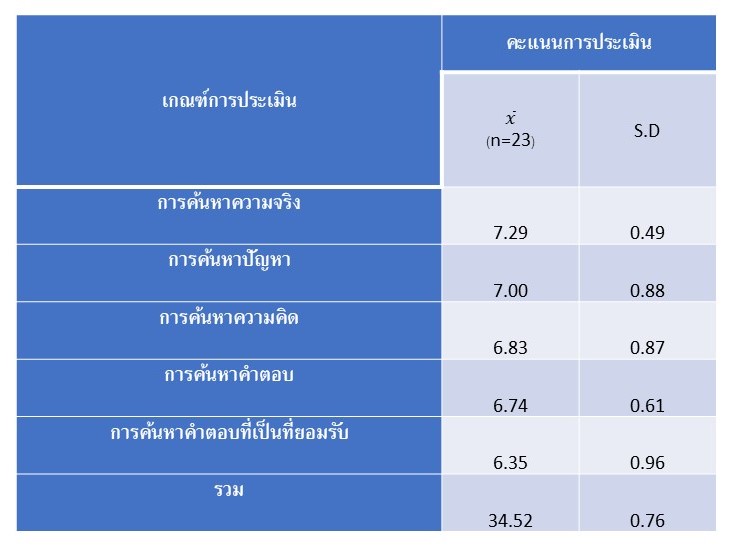ผลของการใช้กิจกรรมการเรียนการสอนบนเว็บร่วมกับการจัดการเรียนรู้ โดยใช้ปัญหาเป็นฐาน เพื่อส่งเสริมการแก้ปัญหาเชิงสร้างสรรค์ ของนักศึกษาระดับปริญญาตรี
Main Article Content
บทคัดย่อ
การวิจัยครั้งนี้มีวัตถุประสงค์เพื่อ 1) ศึกษาคุณภาพของกิจกรรมการเรียนการสอนบนเว็บร่วมกับการจัดการเรียนรู้โดยใช้ปัญหาเป็นฐาน 2) ศึกษาผลของการใช้กิจกรรมการเรียนการสอนบนเว็บร่วมกับการจัดการเรียนรู้โดยใช้ปัญหาเป็นฐานที่ส่งผลต่อความสามารถในการแก้ปัญหาเชิงสร้างสรรค์ของนักศึกษา 3) ศึกษาความพึงพอใจของนักศึกษาหลังการใช้กิจกรรมการเรียนการสอนบนเว็บร่วมกับการจัดการเรียนรู้โดยใช้ปัญหาเป็นฐาน กลุ่มตัวอย่างที่ใช้ในการวิจัยในครั้งนี้ คือ นักศึกษาระดับปริญญาตรี วิทยาลัยนาฏศิลปจันทบุรี ที่ลงทะเบียนเรียนในรายวิชา 300 - 21006 ความเป็นพลเมืองและปรัชญาเศรษฐกิจพอเพียง ภาคเรียนที่ 1 ปีการศึกษา 2566 จำนวน 23 คน โดยการเลือกแบบเจาะจง เครื่องมือที่ใช้ในการวิจัยประกอบด้วย 1) แบบสัมภาษณ์แบบมีโครงสร้าง 2) แผนการจัดกิจกรรมการเรียนการสอน 3) กิจกรรมการเรียนการสอนบนเว็บร่วมกับการจัดการเรียนรู้โดยใช้ปัญหาเป็นฐาน 4) แบบวัดความสามารถในการแก้ปัญหาเชิงสร้างสรรค์ 5) แบบประเมินความพึงพอใจ ผลการวิจัยพบว่า 1) คุณภาพกิจกรรมการเรียนการสอนบนเว็บร่วมกับการจัดการเรียนรู้โดยใช้ปัญหาเป็นฐาน พบว่าในภาพรวมมีคุณภาพอยู่ในระดับมากที่สุด โดยด้านกิจกรรม พบว่า มีคุณภาพอยู่ในระดับมากที่สุด และด้านสื่อการสอน พบว่า มีคุณภาพอยู่ในระดับมากที่สุด 2) ความสามารถในการแก้ปัญหาเชิงสร้างสรรค์ของนักศึกษาพบว่า มีความสามารถในการแก้ปัญหาเชิงสร้างสรรค์อยู่ในเกณฑ์ระดับสูงมาก 3) ความพึงพอใจของนักศึกษาที่เรียนด้วยกิจกรรมการเรียนการสอนบนเว็บร่วมกับการจัดการเรียนรู้โดยใช้ปัญหาเป็นฐานเพื่อส่งเสริมการแก้ปัญหาเชิงสร้างสรรค์ในภาพรวมอยู่ในระดับมาก
Article Details

อนุญาตภายใต้เงื่อนไข Creative Commons Attribution-NonCommercial-NoDerivatives 4.0 International License.
เนื้อหาและข้อมูลที่ได้รับการเผยแพร่ในวารสารวิพิธพัฒนศิลป์ ถือเป็นข้อคิดเห็นและความรับผิดชอบของผู้แต่งเท่านั้น โดยกองบรรณาธิการวารสารไม่มีส่วนรับผิดชอบต่อเนื้อหาหรือข้อคิดเห็นใด ๆ ที่ปรากฏในบทความ
เอกสารอ้างอิง
กิดานันท์ มลิทอง. (2543). เทคโนโลยีการศึกษาและนวัตกรรม (พิมพ์ครั้งที่ 2). อรุณการพิมพ์.
ชญาภรณ์ พัวพานิช. (2554). ผลของการเรียนรู้ร่วมกันด้วยระบบสนับสนุนการปฏิบัติงานบนเว็บ 2.0 ที่มีต่อการแก้ปัญหาเชิงสร้างสรรค์ของนิสิตฝึกประสบการณ์วิชาชีพครู [วิทยานิพนธ์ปริญญาดุษฎีบัณฑิต, จุฬาลงกรณ์มหาวิทยาลัย]. Chulalongkorn University Intellectual Repository (CUIR). https://cuir.car.chula.ac.th/handle/123456789/33586
ชวลิต ชูกําแพง. (2551). การพัฒนาหลักสูตร. ทีคิวพี.
ทิศนา แขมมณี. (2548). ศาสตร์การสอน: องค์ความรู้เพื่อการจัดกระบวนการเรียนรู้ที่มี ประสิทธิภาพ. สำนักพิมพ์แห่งจุฬาลงกรณ์มหาวิทยาลัย.
นิรมล ศตวุฒิ. (2547). การจัดการเรียนรู้ที่เริ่มจากผู้เรียน. วงการครู. 1(7), 8.
ประเวศ วะสี. (2544). ภาวะผู้นำ พยาธิสภาพสังคมไทยและวิธีแก้ไข. พิฆเณศพริ้นติ้ง เซ็นเตอร์.
ประสาร มาลากุล ณ อยุธยา. (2537). ความคิดสร้างสรรค์: พรสวรรค์ที่พัฒนาได้. บพิธการพิมพ์.
ปาริชาติ บุญเอก. (2564, 3 เมษายน). พัฒนาเด็กอย่างไรให้ 'อ่านออกเขียนได้' และ 'วิเคราะห์เป็น'. กรุงเทพธุรกิจ. https://www.bangkokbiznews.com/social/930515
พรรณี เกษกมล. (2546). การสอนบนเว็บ. วารสารวิชาการ, 6(5), 49-50. http://academic.obec.go.th/web/page/104
พัชรา พุ่มพชาติ. (2552). “การพัฒนารูปแบบการจัดประสบการณ์การแก้ปัญหาอย่างสร้างสรรค์สำหรับเด็กปฐมวัย.” [วิทยานิพนธ์ปริญญาดุษฎีบัณฑิต, มหาวิทยาลัยศิลปากร]. สำนักงานการวิจัยแห่งชาติ. https://doi.nrct.go.th/ListDoi/listDetail?Resolve_DOI=10.14457/SU.the.2009.10
รัชนีกร หงส์พนัส. (2547). การเรียนรู้แบบใช้ปัญหาเป็นฐาน: ความหมายสู่การเรียนการสอนกลุ่มสาระการเรียนรู้สังคมศึกษา ศาสนาและวัฒนธรรม. วารสารมนุษยศาสตร์ปริทรรศน์. 1(26), 44-53. https://ejournals.swu.ac.th/index.php/hm/article/view/644
เรียนา หวัดแท่น. (2566). การพัฒนากิจกรรมการเรียนการสอนบนเว็บร่วมกับการจัดการเรียนรู้แบบปัญหาเป็นฐาน เพื่อส่งเสริมการแก้ปัญหาเชิงสร้างสรรค์ของนักศึกษาระดับปริญญาตรี [เอกสารไม่ตีพิมพ์]. รายงานการวิจัยทุนสนับสนุนวิจัยการเรียนการสอน ประจำปีงบประมาณ พ.ศ. 2566 สถาบันบัณฑิตพัฒนศิลป์.
วีระ สุดสังข์. (2549). การคิด วิเคราะห์ คิดอย่างมีวิจารณญาณ และคิดสร้างสรรค์. ชมรมเด็ก.
สํานักงานคณะกรรมการการอุดมศึกษา. (2552). แนวทางการปฏิบัติตามกรอบมาตรฐานคุณวุฒิระดับอุดมศึกษาแห่งชาติ พ.ศ. 2552. สำนักงานคณะกรรมการการอุดมศึกษา. https://shorturl.asia/kjcHt
Anderson, B. (1975). Cognitive psychology: The study of knowing, learning, and thinking. Academic Press.
Barrows, H. S. (2000). Problem-based learning applied to Medical Education. Revised edition. School of Medicine, Southern Illinois University.
Bonk, C. J., & Reynolds, T. H. (1997). Learner-centered web instruction for higher-order thinking, teamwork, and apprenticeship. In B. H. Khan (Ed.), Web-based instruction. Educational Technology Publications.
Delisle, R. (1997). How to use Problem-based Learning in the Classroom. Association for Supervision and Curriculum Development.
Ellison, J. G. (2009). Increasing problem solving skills in fifth grade advanced mathematics students. Journal of curriculum and Instruction, 3(1), 15.
Jones, C., & Seguin, P. J. (1997) Transaction costs and price volatility: Evidence from commission deregulation, American Economic Review, 84, 728-737.
Khan, B. H. (1997). Web-based instruction. Englewood Cliffs. Educational Technology Publications.
Lee, J., & Young, C. (2011). “Building wikis and blogs: Pre-service teacher experiences with web-based collaborative technologies in an interdisciplinary methods course.” THEN: Technology, Humanities, Education & Narrative 8, 8-37.
Parson, R. (1997). Glossary of CBT/WBT terms. OSIE. http://www.osie.on.ca/~rpason/out 1d.htm
Quellmalz, E. S. (1985). “Needed Better Method for Testing Higher Oder Thinking Skill,” Educational Leadership. 43(6), 29-34.
Russell, David H. (1956). Children’s Thinking. Oinn and Company.
Shean, J., & Mary, K. (1985). “The Problem Solving Program: An Investigation of Effect of Problem Solving Ability.” Dissertation Abstract International, (November), 2-8.
Torrance, E. P. (1966). Torrance Test of Creative Thinking. Personnell Press, Princeton.
Treffinger, D. J., Isaksen, S. G., & Dorvol, K. B. (2004). Creative Problem Solving: AnIntroduction. Prufrock Press.


